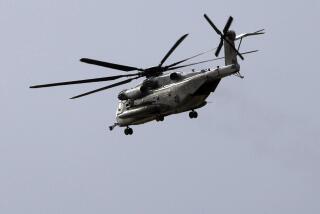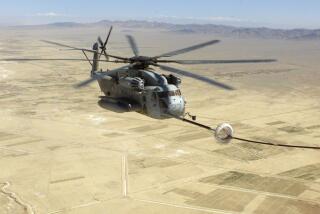Apache Crashes Raise Doubts About Helicopter’s Capabilities
- Share via
TIRANA, Albania — The fiery crash of another Apache helicopter in the Balkans has further complicated the mission of a combat aircraft that has come to symbolize both the potential strengths--and practical limitations--of the allied air war.
As the Army began investigating a crash that killed two pilots early Wednesday, Pentagon officials predicted that alliance commanders will need to engage in still more study before they finally give the go-ahead for the controversial Apache mission that has already been six weeks in preparation.
The copter, manned by Chief Warrant Officer 3 David A. Gibbs, 38, of Massillon, Ohio, and Chief Warrant Officer 2 Kevin L. Reichert, 28, of Chetek, Wis., crashed in a remote, mountainous area 50 miles northeast of the Task Force Hawk base here, in what mission spokesman Lt. Col. Garrie Dornan described as “total blackout conditions.”
Flying with other AH-64 gunships in a terrain marked by towering crags and plunging gorges, the helicopter went down after exploding into a fireball about 1:30 a.m. Albania time.
Officials said the investigation would take days. But speculation among analysts focused on the possibility of aircraft malfunction, pilot error or the Apache’s inability to detect the power lines that snake across the region.
The crash occurred far enough from the Yugoslav border that officials said hostile gunfire was not a possibility.
NATO commanders ordered 24 of the Apaches to northern Albania last month in hopes that the firepower that proved so formidable in the Persian Gulf War could destroy the Yugoslav ground forces and air defenses that have vexed the Western alliance since the air campaign began.
But the Apaches were slow to arrive from Germany, and the accompanying 5,300 troops have since been engaged in extensive training to help them cope with a terrain that is tougher than any they have confronted.
Wednesday’s accident, which follows an April 26 Apache crash in which the crew members survived, highlighted the risks confronting alliance forces in a frighteningly unfamiliar land.
Publicly, officials emphasized that the group’s training regimen would continue and insisted that the Apache’s combat debut in the Balkans would not be delayed.
The Apaches “are well on track, and they will be in the theater soon,” German Air Force Maj. Gen. Walter Jertz, a NATO spokesman, said in Brussels.
Yet with the accident inflicting the first casualties of the air campaign, “it’s only logical that they make sure everything is in order” before they begin trying to attack Yugoslav targets, said one U.S. defense official.
Pentagon officials and defense experts said training accidents occur regularly with military aircraft. About 130 military personnel have been killed on average in each of the past six years in such mishaps, they noted.
Several officers acknowledged that the crashes raise new questions about the wisdom of sending the Apaches to Albania in the first place, which remains a major issue within the Pentagon.
While the helicopters were highly successful in busting tanks in 1991 in the featureless terrain of Iraq, in the Balkans they must cope with rugged mountains and highly mobile enemy troops, whose equipment is widely dispersed rather than conveniently concentrated.
Crews of the Apaches, which are designed for night operations and ground-hugging support for infantry troops, must take pains to avoid hitting the Albanian refugees who are on the move, and must be mindful of NATO’s desire to prevent allied casualties.
One defense analyst said Gen. Wesley K. Clark, NATO’s supreme allied commander in Europe, had created a public relations mess by formally requesting the weapon March 24.
While Clark no doubt understood the aircraft’s limitations, the public began to regard the Apache as the tool that would wipe out Serbian field forces and halt “ethnic cleansing,” said former defense official Daniel Goure, now an analyst with the Center for Strategic and International Studies in Washington.
As expectations soared, “he got blindsided,” Goure said.
Though initial reports said the downed Apache may have gotten snarled in power lines, Pentagon officials played down that possibility. But officials acknowledged that hazards were everywhere.
“We fly aggressive mission profiles. We are flying at night with full loads over treacherous terrain. It is a hazardous business, and you cannot eliminate risk from this business,” Dornan said of the crash.
Both crewmen were dead when rescue and ordnance demolition teams arrived at the crash site within 15 minutes of the accident, the spokesman said. Some of the armaments on board had detonated, consuming the aircraft in a fireball as it fell to the ground, he added.
Investigation into the April 26 crash has yet to reveal what caused that accident. But mission officers reported that the two crewmen, who ejected safely with minor injuries, said the aircraft caught fire before going down.
As word of the deaths spread among the 5,350 U.S. troops at the still-makeshift camp here, Dornan said that the mood was “mournful” but that the troops stand ready to launch combat operations when their NATO commanders instruct them.
“There will be no delay in the timeline. There are no aircraft grounded as of today,” said Dornan.
“Obviously, we will be looking very hard at our procedures,” he added. “We will look very hard at what we are doing and will take the necessary steps that we feel appropriate to ensure we’re successful in our mission.”
The heavily armored Apaches, which can carry 16 “tank-killer” Hellfire missiles, 38 2.75-inch rockets and 1,200 rounds of high-explosive ammunition for their 30-millimeter guns, were dispatched to Tirana more than two weeks ago. That was three weeks after President Clinton announced they were being sent to intensify the air operations against Yugoslav forces.
The Apaches have yet to get involved in any combat action.
The attack helicopters are usually deployed together with ground troops, which NATO officials have repeatedly insisted are not in the offing. But guerrillas with the Kosovo Liberation Army contend that they are preparing to be NATO’s foot soldiers.
“We are their ground troops,” KLA spokesman Visar Reka said of the anticipated Apache action, claiming that fellow guerrillas meet regularly with NATO reconnaissance officers posted along Albania’s border with Kosovo to inform the alliance about the latest Yugoslav troop movements.
During a visit here Saturday, several U.S. Congress members expressed doubts about the wisdom of deploying the Apaches in the absence of infantry that could engage Yugoslav forces while the helicopters blast away at the Serbs’ hardware.
U.S. Rep. Marshall “Mark” Sanford (R-S.C.) told the military personnel that he was fearful that the pilots might be headed for “suicide missions.”
During a visit to the troops here Tuesday, only hours before the fatal Apache crash, NATO commander Clark declined to say when the Apache crews would see combat but insisted they were ready to do their part.
“They are very, very prepared right now,” Clark told reporters. “They are increasingly sharpening heir skills, and we certainly intend to use them.”
*
Williams reported from Tirana and Richter from Washington. Times staff writer John-Thor Dahlburg in Brussels contributed to this report.
(BEGIN TEXT OF INFOBOX / INFOGRAPHIC)
Apache Accidents
The $16-million Apache attack helicopter has been involved in several training mishaps over the past decade, including:
Wednesday: Albania. Two crew members killed.
April 26: Albania. Two crew members escape with minor injuries.
Dec. 4, 1997: San Saba, Texas. Both crew members killed.
March 6, 1995: Conroe, Texas. Two crew members injured.
Sept. 27, 1994: Mesa, Ariz. Apache collides with another helicopter, killing one person and critically injuring another.
Nov. 2, 1993: Brady, Texas. Two soldiers injured.
Nov. 15, 1990: Ft. Hood, Texas. Fate of crew not available.
Source: Times staff and wire reports
More to Read
Sign up for Essential California
The most important California stories and recommendations in your inbox every morning.
You may occasionally receive promotional content from the Los Angeles Times.












